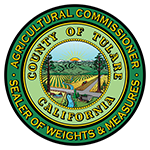California Code of Regulations
Division 6. Pesticides and Pest Control Operations
Chapter 3. Pest Control Operations
Subchapter 3. Pesticide Worker Safety
Article 2. General Safety Requirements
6746. Closed Mixing Systems Requirement.
Closed mixing systems are engineering controls used to protect workers from dermal hazard when mixing pesticides with high acute dermal toxicity. The dermal toxicity of a pesticide is determined by the precautionary statements on the label.
(a) When mixing liquid formulations of pesticides for the production of an agricultural commodity, the employer shall assure employees use an appropriate closed mixing system as specified by this section or pesticide product labeling.
(b) Employees who mix liquid pesticide products, including adjuvants, bearing the statement "Fatal if absorbed through skin" or other comparable language shall use a closed mixing system that is capable of enclosing the pesticide while removing the contents from its original container, preventing the pesticide from contacting handlers. Each emptied pesticide container must be rinsed and drained as required by the pesticide product label or section 6684, and while still connected to the closed mixing system. A closed mixing system meeting this standard is a "Tier 1" closed mixing system.
(c) Employees who mix liquid pesticide products, excluding adjuvants, bearing the statement "May be fatal if absorbed through skin" or "Corrosive, causes skin damage" or other comparable language shall use a closed mixing system that is capable of enclosing the pesticide while removing the contents from its original container, preventing the pesticide from contacting handlers. A closed mixing system meeting this standard is a "Tier 2" closed mixing system.
(d) The employer shall assure employees operating a closed mixing system are trained in its use pursuant to section 6724 and operate the closed mixing system in accordance with its written operating instructions.
(e) All personal protective equipment (PPE) required by the pesticide product label, restricted material permit conditions, or regulation must be at the worksite during operation of the closed mixing system and available in a condition that provides the intended protection. Protective eyewear must be worn while using a closed mixing system. While using a closed mixing system, PPE requirements may be reduced or modified as provided in section 6738.4.
(f) Closed Mixing System Design Criteria - A closed mixing system must meet the following design criteria.
(1) Any closed mixing system used, as required by this section, must be designed to remove a pesticide from its original container and transfer the pesticide product through connecting hoses, pipes and couplings that are sufficiently tight to prevent exposure of any employee to the pesticide concentrate or, when rinsing is required, the rinsate.
(2) Properly Constructed
(A) All elements of the closed mixing system, such as hoses, connectors, and valves, must be designed and maintained for the pesticides being transferred and the pressures or vacuums being generated during system operation.
(B) Tier 1 closed mixing systems must provide for effective rinsing of the original pesticide product from the emptied container as specified by section 6684 and transfer the rinsate to the mix or spray tank.
(C) Tier 1 closed mixing systems must provide adequate pressure and volume of rinse water to rinse the inner surfaces of the pesticide container and must not rupture the container by over pressurizing.
(g) Written Operating Instructions and Maintenance Requirements.
(1) Any employee using a closed mixing system must have written operating instructions.
(2) The written operating instructions must include: operating procedures for use, including the safe removal of a probe; maintenance, cleaning and repair; known restrictions or limitations relating to the system, such as incompatible pesticides, sizes (or types) of containers or closures that cannot be handled by the system; any limits on the ability to measure a pesticide, or special procedures or limitations on the ability of the system to handle partial containers.
(3) The written operating instructions must be clearly legible and available with the closed mixing system and available for inspection by the Director or commissioner upon request.
(4) The employer shall assure that the closed mixing system is cleaned and maintained as specified in the written operating instructions, and as needed to ensure the closed mixing system functions properly.
(h) Exemptions. The requirements of this section do not apply to:
(1) Mixing pesticides using a method or mixing device required by the pesticide product label and the failure to follow the label directions would result in the use of a pesticide in conflict with labeling, as specified in Food and Agricultural Code section 12973.
(2) Opening of a container by removal of the manufacturer's original sealing device without removing any of the contents before re-closing with a liquid-tight sealing device.
(3) Regulatory personnel collecting samples of pesticides.
(4) The rinsing of refillable pesticide containers that are required to be returned to a pesticide dealer, pesticide registrant, or manufacturer (pesticide producing establishment registered by the U.S. Environmental Protection Agency).
(5) An employee required to use a Tier 2 closed mixing system if the employee handles a daily maximum of one gallon or less. The employee shall wear all personal protective equipment required by pesticide product labeling and regulation when not using a closed mixing system.
 Tulare County Agricultural Commissioner/Sealer of Weights and Measures Department
Tulare County Agricultural Commissioner/Sealer of Weights and Measures Department